Year of Indigenous Languages: Hindi and Filipino
December 9, 2019The United Nations has declared 2019 as the International Year of Indigenous Languages. To celebrate, for each month this year, you’re invited to view greetings for different languages.
To conclude the ‘Year of Indigenous Languages’, we feature the languages Hindi and Filipino:
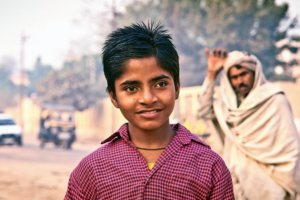 Hindi
Hindi
शुभ प्रभात!
आज आप कैसे हैं?
भगवान आपका भला करे!
shubh prabhaat!
aaj aap kaise hain?
bhagavaan aapaka bhala kare!
Good Morning!
How are you today?
May God Bless you!
Filipino
Nasa Diyos ang awa, nasa tao ang gawa. – With God is mercy, with man is action. God gives mercy to those who help themselves.
Ang nagmamataas ay ibababa, at ang nagpapakumbaba ay itataas. – Humble yourselves before the Lord, and He will lift you up. (From Matthew 23:12 “For whoever exalts himself will be humbled, and whoever humbles himself will be exalted.”)
Photo: Boy in India obtained from pxhere. Used with permission.
Thank You Sr Mary Ryan
December 8, 2019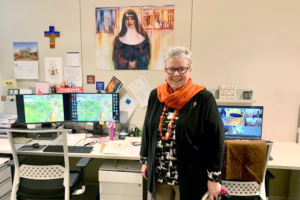 Thank you!
Thank you!
The word thank you seems inadequate to show our deep appreciation to Mary Ryan rsj (South Australia) for her monthly reflections on Mary MacKillop for the ‘Inspiration from our Founders’ section in the Mary MacKillop eNews over the past ten years.
Sr Mary, your contributions have enabled many readers to enter more fully into an understanding of St Mary of the Cross and her strong faith in the power of God’s unbounding love for each of us.
Kath Hitchcock rsj
Chair
Congregational Communications Team
You’re invited to view all of Sr Mary’s reflections below:
‘Inspiration from Mary’ articles
Christmas Messages for 2019
Regional Leaders and Sisters representing their regions, have provided Christmas messages for you to reflect on and enjoy…
Christmastime In Ireland
Christmastime in Ireland means the weather is dark, damp and cold and we are all layered in thick jumpers, padded coats, warm gloves, woollen scarves and hats and strong boots. The shops sparkle with Christmas gifts and treats and when darkness falls, the festive lights brighten the streets, reminding everyone that Christmas is nigh. A sense of urgency permeates everything. People make lists of gifts to be bought and food to be ordered. Carol singers gather on street corners and in shopping centres, singing their hearts out to raise money for the poor and the homeless, children prepare their Christmas plays and parents take them to visit Santa Claus. The prevailing atmosphere centres on family and parents yearn for the homecoming of their adult children, who for economic reasons, emigrated to other countries.
As Christmas Day draws closer the television channels show coverage of the welcoming scenes at the airports. New babies, new husbands or new wives are introduced to their new Irish family amid tears of joy and warm hugs. Those of us watching from the comfort of our homes join in the tears, remembering the sadness of years, lived away from loved ones.
Christmas Eve is all about the final purchase, the preparation of the food and Midnight Mass. Empty churches are filled once more, carols are sung and emotions run high, brought on by the sight of the children gathered around the Christmas Crib or the young adults, who have ceased to believe, once more joining in the singing of Silent Night. The absence and memory of loved ones is felt but the sadness is hidden.
On Christmas Day with the conclusion of the church services, the streets are silent as everyone is indoors. Families gather in their warm houses, the poor in church halls and everyone is enjoying the turkey, or the salmon, with all the trimmings. For most families the celebrations continue for a number of days, as the extended family meet to share songs and stories. Eventually Christmas slides into the New Year and waits for another year to re-appear.
Clare Ahern rsj
Dublin
Ireland Region
Jesus is the Reason for the Season
Some years ago, I was given a badge with the words “Jesus is the reason for the season” on it. At the time I thought it was a bit over the top and felt a little self-conscious about wearing it. Now twenty years later I wish I still had it as I walk around shops playing yet another version of “I’m dreaming of a white Christmas” or surrounded by Surfing Santas!
Amid the hype about buying the perfect gift for that special someone, we have lost the message about the coming of the Christ into every aspect of our lives.
The incarnation reminds us that in the Christmas event God is revealed as radical love. Jesus, the most extraordinary gift, has already been given.
This gift speaks of relationship. Jesus came into a family, lived in Nazareth, reached out to those who were vulnerable, and gave witness to an all-inclusive love. During the past year the Sisters reflected on the message of the Good Samaritan in the lead up to the General Chapter. We pondered the gracious generosity of the outcast, who not only stopped to assist the man attacked by robbers but who, in gracious generosity, offered to pay whatever was owed to the innkeeper.
This radical self-emptying love so evident in the life of Jesus is what we celebrate at Christmas.
The greatest gifts we can offer our world then are those which give witness to this radical self-emptying love.
The recent bushfires have evoked a sense of that love along with a deepening understanding our interdependence with all of life among the wider community and have reminded us that we share a common humanity. The smoke haze that has enveloped our cities and towns many miles from the bushfire centres have reminded us too that whatever we do in our part of the planet, can and does affect the whole cosmos.
This Christmas as we celebrate with family and friends let our focus be on “Jesus as the reason for the season” and make a commitment to giving witness to the radical love of our God by reaching out to the vulnerable whether they be the victims of the bushfires or drought; by speaking out for justice and mercy for refugees and asylum seekers; or by offering a compassionate response to those on the edge of our society, the homeless poor, the victims of domestic violence or for those seeking reconciliation for our indigenous brothers and sisters.
Radical, self-emptying love draws us into communion with God and this is the fundamental reason for celebrating the season.
Mary Ellen O’Donoghue rsj
Regional Leader
New South Wales Region
Christmas – Season of Graced Partnerships
 Artists, bands and soloists often have a signature tune which identifies their iconic message. Christmas gives us clear insight into God’s signature issues.
Artists, bands and soloists often have a signature tune which identifies their iconic message. Christmas gives us clear insight into God’s signature issues.
By re-acquainting ourselves with the ‘graced partnerships’ of the Advent and Christmas Narratives, we get vital clues about God’s signature issues. We discover that invariably. God reversed the world’s expectations.
When dealing with God, expect the unexpected!
Partnerships that delivered God’s Message to the world.
Jesse and David – God’s spirit rested upon the seemingly dead root of Jesse. If DNA testing had existed, it would have proved Joseph’s descent from David. Jesus’ genealogy showed he came from a flawed, if not ‘dodgy’ ancestry. He came as a helpless baby not a triumphant Messiah.
This partnership reminds us to look at others with wonder and appreciation regardless of their background, status or power.
Mary and Joseph – Joseph, newly engaged to Mary, faced a baffling and painful enigma. Following the angel’s advice, he reversed a former, anguished decision and took Mary into his home as his wife and the baby as his own.
This partnership is a reminder to us to have the courage and flexibility to adapt our life’s plan to the responsibilities of love.
Jesus and John the Baptist – How they loved each other! But the austere John and the sociable Jesus were both destined to be rejected. They were radically different in personality but united in love.
If we follow their example, our appreciation of difference will grow and our judgement decline.
Mary and Elizabeth – Elizabeth, despite her old age and Mary, despite her virginity witnessed that out of emptiness and barrenness God can miraculously create new life.
When we experience emptiness, God calls us from barrenness to fruitfulness. These fierce moments make huge demands but let us emulate the boundless joy of the Visitation.
Elizabeth and Zechariah – John’s birth was a sign of God’s mercy to Elizabeth. Family and friends expected the child to be called Zechariah, but Elizabeth insisted on ‘John’. Objecting to this departure from cultural norms and tradition, the gathering appealed to Zechariah who sent them a ‘text message’: ‘His name is John’.
Let us rejoice that John’s parents put attentiveness to God before iron-clad customs and expectations.
Simeon and Anna – Simeon announced Jesus to be the light to the nations, a sign to be opposed. He prophesied that Mary’s heart would be pierced. Anna of great age ‘came by at that moment’ as a sign of hope and source of strength for the distressed young woman.
Let us listen to the wise ones who see further than we can see and strengthen us to face whatever comes.
The Baptist prods us on to newness,
and the Zachary in us resists until our Elizabeth insists.
Our Joseph lets it happen,
and the young Mary in us seizes the gift
and runs with it.
It must be so if the Christ in us is to be born.
Margaret Cleary rsj
Regional Leader
CentreWest Region
Earth Blesses
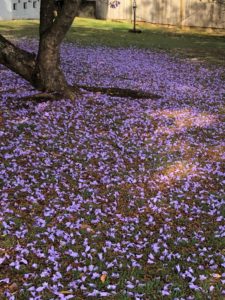 The call of our 27th Chapter begins with the word, Listen. As we enter this Christmas time, the call to listen to Earth, is compelling. Everything is dry. The smell of smoke continues day in and day out. Fire rips through our tinder dry, drought-stricken land, devastating people’s lives, businesses, animals and plants. It goes on and on and the weather reports are bereft of relief and hope.
The call of our 27th Chapter begins with the word, Listen. As we enter this Christmas time, the call to listen to Earth, is compelling. Everything is dry. The smell of smoke continues day in and day out. Fire rips through our tinder dry, drought-stricken land, devastating people’s lives, businesses, animals and plants. It goes on and on and the weather reports are bereft of relief and hope.
Distracting us are the flowering trees of this season, richer in colour because of drought: the strength and vibrancy of colour of the Jacaranda, Poinciana, Frangipani, Bougainvillea and the Flame Tree. Our hearts and minds can be so cluttered at this time with the end of year business and the pounding we get from advertising and the Christmas ‘Jingle Bell’ types of music blaring out everywhere. It can be hard to stop and to listen but listen we must to be both blessed and nourished by Earth.
 Like the soft mauve of the Jacaranda delighting my senses, may I be open to receive and be blessings of deep peace and joy for our world.
Like the soft mauve of the Jacaranda delighting my senses, may I be open to receive and be blessings of deep peace and joy for our world.
May I be as bright and strong as the red Flame tree, being light that shines in the darkness, a light that darkness can never overcome.
Like the fragrant yellow centre of the Frangipani, may I be drawn into the heart and mind of the One who comes among us bringing Good News.
May the thorns of the Bougainvillea remind me of the harshness of the One born in exile and all those exiled from homeland, family and friends this Christmas.
Like the shade given by the Poinciana, may I settle gently and often into the invitations of the Word, who is life.
Oh, come all people, let us greet the One who comes, the God of light, hope, love, invitation, joy and compassion.
Come, let us with all of Creation, give praise and thanks.
Annette Arnold rsj
Regional Leader
TransPacifico Region
Now the Work of Christmas Begins…
When the song of the angels is stilled,
when the star in the sky is gone,
when the kings and princes are home,
when the shepherds are back with their flocks,
the work of Christmas begins:
to find the lost,
to heal the broken,
to feed the hungry,
to release the prisoner,
to rebuild the nations,
to bring peace among the people,
to make music in the heart.
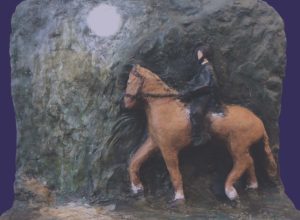 I love this artwork of Marea Cox. It is a depiction of Julian Tenison Woods while in Penola Parish and it is titled “Riding by Night”. Julian spent 10 Happy Years in the Bush, riding from farm to farm, small town to small village, bringing whatever he could to the families in this widespread and isolated area of the continent. What did he really bring when he dismounted his horse and greeted the person? What did he really say to make a difference; to make his visit worthwhile? Why did he ride to the end of the road to meet a family?
I love this artwork of Marea Cox. It is a depiction of Julian Tenison Woods while in Penola Parish and it is titled “Riding by Night”. Julian spent 10 Happy Years in the Bush, riding from farm to farm, small town to small village, bringing whatever he could to the families in this widespread and isolated area of the continent. What did he really bring when he dismounted his horse and greeted the person? What did he really say to make a difference; to make his visit worthwhile? Why did he ride to the end of the road to meet a family?
With the stars and moon to guide, with his gospel message in his heart, I believe he was reworking the Christmas message in his own life and in the lives of his parishioners.
Have a reflective and meaningful Christmas where ever you are and with ever you happen to meet along your way.
Kerrie Cusack rsj
Regional Leader
Victoria-Tasmania Region
Australian Catholic Youth Festival, Perth
Welcome to the Australian Catholic Youth Festival 2019, Perth.
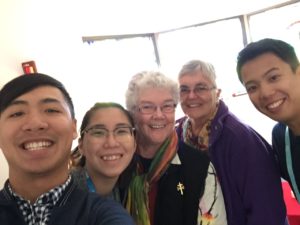 The Australian Catholic Youth Festival (ACYF) is a national gathering of Catholic young people that has been established by the Australian Catholic Bishops Conference (ACBC).
The Australian Catholic Youth Festival (ACYF) is a national gathering of Catholic young people that has been established by the Australian Catholic Bishops Conference (ACBC).
It exists to provide young people with opportunities to deepen their relationship with Jesus and to be empowered to be disciples in the world today and to encounter and celebrate the vitality of the church in Australia.
The Festival will use the scripture focus of the 2020 Plenary Council by adopting the theme: “Listen to what the Spirit is saying” (Rev 2:7).
The Perth Archdiocese is hosting this event from December 8 – 10 in the Perth Convention Centre close to the scenic Swan River.
Excitement is building up and so is a movement around Australia for the “Word “has been passed around. Young people are travelling as Pilgrims to Perth’s Holy Ground. They’ll cross Bass Strait and fly over the Nullarbor, and be warmly welcomed by the Youth of WA
They have heard the whisperings of the Holy Spirit and God has touched their hearts.
In 1868, when 26-year-old Mary MacKillop wrote to her Mother Flora, she said: “Believe in the whispering in your own heart”. Mary’s word rings true to the young people of today as they listen to what the Spirit is saying in their hearts.
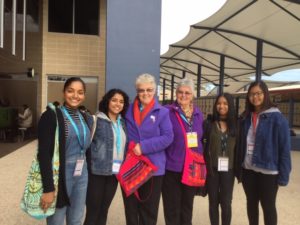 In his letter to the youth of the world, “Christus Vivit”, Pope Francis writes: “The young are in my heart.”
In his letter to the youth of the world, “Christus Vivit”, Pope Francis writes: “The young are in my heart.”
He challenges them to “Stand up and make your voices known today.” He reminds the young about how important it is for them to have an active role in the Church today and calls them to take risks in following in the footsteps of Jesus with the words:
Australian Catholic Youth Festival Expo 2019
The Encounter Expo will be such a hive of activity at the Festival that the participants will be sure to return to again and again. It will be an interactive and dynamic space in which they will be invited to encounter the breath of the Catholic Church in Australia in new and unexpected ways.
There will be more than 80 separate stalls at ACYF Expo 2019. Participating Catholic agencies, organisations, religious orders, ecclesial movements and numerous other Catholic groups from across Australia will offer a range of interactive and experiential activities through which to explore the variety of ways by which the Church’s mission in Australia is being carried out.
Highly engaging, informative and fun – the EXPO will be the PLACE to be…
Please continue reading the article here (PDF)
Maree Riddler rsj
View photos in the photo gallery below:
A Day in the Life: Christmas Messages from Committee Chairs
The Sisters of Saint Joseph have committees covering different aspects of the Congregation such as communications and justice.
For this month’s A Day in the Life feature, the Chairs from the Committees were asked to provide a Christmas message. You’re invited to view the messages below:
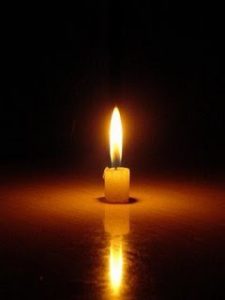 Congregational Immersion and Discernment of Call (CIDC) Team
Congregational Immersion and Discernment of Call (CIDC) Team
The Gift of You and the Gift of Me
Of all the feast days that Christianity celebrates Christmas is the one that has a clear focus on humanity – you and me. We are Gifts – the spark of divinity shines in each one of us. That is what the story of Christmas tells us. That is what the ‘gift-giving’ surely means. We treasure each other as ‘gift’ and at Christmas we have a chance to express this to others as they do to me. Oh how careful I’m becoming with my words in the Christmas card to let another know how she/he is ‘gift’. That is far more important than the ‘present’ accompanying it, I believe.
A simple poem says it:
Does our delight reside in things?
Or are the feelings in our hearts
the real gift Christmas brings?It’s surely seeing those we love
and sending messages too.
Appreciating people as they are.
Special people just like you.
The Congregational Immersion and Discernment of Call (CIDC) Team send everyone heartfelt blessings and gratitude for the gift each of you are and pray that peace and joy raise your hearts this Christmas.
Katrina Brill rsj
Congregational Communication Team (CCT)
Gathered together, we await the light.
Standing together, we trust in the light.
Praying together, we hope for the light Seeking together, we step into the light.
Singing together, we are blessed by the light.
Wishing each reader a blessed and peace-filled Christmas.
Kath Hitchcock rsj
Eco-Spirituality Team
The Angels greeting to the Shepherds was of course, ‘Peace to all people of good will.’ That’s the greeting the Congregational Eco-Spirituality Team wish for all at this blessed time of Christmas.
Recently commenting on Pope Francis’s 2019 visit to three African countries, Tablet journalist Christopher Lamb summed up Pope Francis’s core priorities as ‘a seamless garment’ in defence of the poorest and most vulnerable that embraces the protection of the planet.’ (Tui Motu InterIslands October 2019)
That’s the constant refrain of our Team – the interconnectedness of life. As our report to the recent Josephite Chapter noted:
Please continue reading below:
Eco-Spirituality Team Christmas Message (PDF)
Eco-Spirituality Team Members
Josephite Justice Network (JJN)
we stand conscious of the huge disparities in our world.
And we are both called and blessed.
Confronted by family and global violence, the frightening reality of the arms race, the accelerating wealth gap and the ongoing shattering of lives,
we are blessed by the witness of Pope Francis and all those who call for peace and transformation.
Listening to our First Nations brothers and sisters, who long for truth to be told and their legitimacy recognised, so that we can live as one.
we continue to be blessed by our First Peoples.
With those pushed to the edges of our world and the more than 64 million who remain displaced in this season,
we are blessed in the birth of a child who was himself displaced and who attests to our belief that love continues to be born.
Faced by the absolute futility of a broken political system, which uses human beings as political pawns and denies welcome to those who seek safety on our shores,
we are blessed by the reminder of the Good Samaritan to be neighbour to all.
Faced with the obstacles to justice, equity and kindness which face us in a material-centred world space,
we are blessed by the love and support we find in one another.
In the challenge to care for our common home beyond the disruption and damage of greed and power,
we are blessed by those who call for protection of Earth.
As we listen for Christmas
in the fabric of our hope
and the realities that confront us –
…In the stillness of our waiting
and our fear for those
who suffer most at our hands
you call us O God
to make room for all
in our hearts
and in our world
FOR IN ALL OF THIS,
YOU CONTINUE, O GOD, TO BE BORN
Jan Barnett rsj and JJN
International Josephite Associates Leaders Team (IJALT)
 Christmas Blessings
Christmas Blessings
A blessing is the gift of God’s grace.
At Christmas we celebrate the greatest gift that God has given us, that of his Son.
We celebrate this Gift in offering God’s grace through words of blessings to others… in a greeting card, a word spoken, an email greeting…
Josephite Associates are truly blessed to share, with many others, in the spirit of Mary MacKillop and Julian Tenison Woods. In this season of Hope and Peace we share this blessing with all:
May the faithfulness of Mary and Joseph inspire us to be people of faith
May the babe born in Bethlehem bring renewed hope into our world
May the coming year be one of peace and fulfilment
Mary Hemmings
Conference of Josephite Leadership (CJL) Archivists’ Committee
As the Conference of Josephite Leadership Archivists’ Committee reflects on its ultimate mission to safeguard and share the Josephite story, our gift to you this Christmas is a poem preserved in the Sisters of St Joseph Congregational Archives, written by Father Founder, Julian Tenison Woods.
The Committee wishes everyone the best of blessings for a peaceful and joyful Christmas.
The Infant Jesus
Fills my soul with peaceful calm?
‘Tis the Infant King of heaven,
Unto all poor sinners given,
Round Him loudly, loudly call
Sweet mercy, Lord, on all.
Who is this with smile so sweet,
Plays at Joseph’s lovely feet?
‘Tis the little Child of heaven,
Unto all His children given;
Call upon Him louder still,
Ask for nothing but His will.
What is that enchanting grace
Playing round His lovely face?
Telling us to call Him brother,
Pointing to His darling Mother.
Let us have no prayer but one,
Only Thy sweet will be done.
Waiting, I have waited long,
With the same unceasing song,
Hear, Oh Child, my piteous cry,
Let me love or I shall die,
Let me love along with You,
Mary and Saint Joseph too.
CJL Archivists’ Committee
A Raindrop Story
December 7, 2019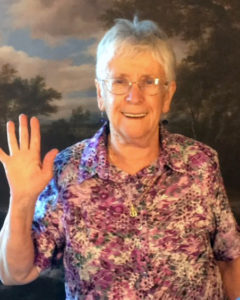
A Raindrop Story…
I love to listen to stories that paint all manner of pictures and that take me along with the characters.
In 1985 whilst on a Renewal programme at Baulkham Hills, we were invited to write/welcome our own sacred myth. We were encouraged to just let it flow without any censoring. A suggested way to begin: ‘Once upon a time…’or ‘Many many years ago…’
This became an amazing experience for me and has been a source of healing and delight whenever I let it into my heart.
With trust I will share it with you:
My Sacred Myth
Many many years ago… too many years ago in fact,
a tiny raindrop fell from the heavens…
O what a great and wonderful night that was! For the whole earth
rejoiced at the birth of that little raindrop.
Where did the raindrop fall? Into a gutter on a cold, dark rainy night.
Who found the raindrop? A black cat
who happened out of bounds.
…he picked up the tiny wee raindrop as he passed the gutter and quite soon was making his presence felt at the back step of a tiny little house set among other little houses, two storey ones, that were often the cause of surprise, pain, fear and love… and many other experiences …too many to record here.
I’ll tell you now who opened the back door – a mother raindrop
with a gentle smile.
She brought in the little black cat , dried it with a towel
and placed it by the fire.
She then attended to this newly found little creature
by placing it in her heart.
Quietly, on tip toe in fact, she made her way over
to the father raindrop who was attending to the other raindrops
In that household.
They all seemed to look up together and what an explosion of love
As they all exclaimed together:
Our new baby raindrop, why not cal her JOY?
At that moment that new little raindrop quivered with joy
And still quivers to this day.
So that you’ll never think this story is lop-sided, I’ll tell you this….
Life for this new little raindrop did not prove to be all joy!!!
In fact, if we really concentrated on our sums, we’d find that the score
would read something like this…
95% sorrow… 5% joy
however, these two totals make up LOVE…
P.S. My mother used to tell me that a black cat brought me in on a rainy night.
Pattie Snudden rsj
Fr Julian: Man of Words – Letter Eleven
December 6, 2019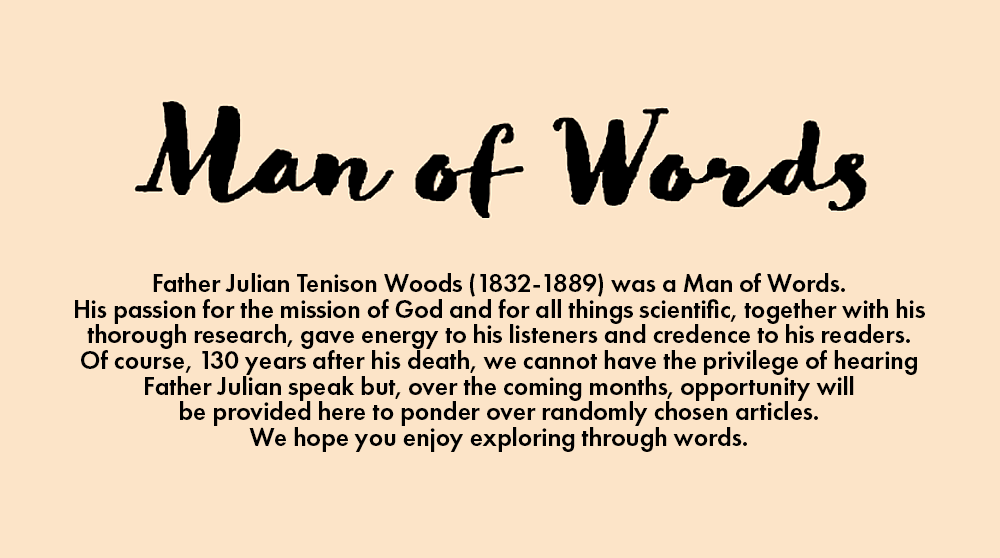
Tasmanian Forests: Their Botany and Economic Value [i] was the title that Father Julian Tenison Woods gave the paper he read at the meeting of the Royal Society of NSW on 5 June 1878.
In the paper Father Julian presented his observations of the forests he found in Tasmania from 1874-1876. He described various types of trees in detail and made comparisons with similar trees in other parts of Australia. He described meticulously the process of harvesting and sawmilling of timber, as well as the uses for which it is gathered. At times it is easy to imagine oneself standing among the stately trees and using all one’s senses to paint a picture of the surroundings.
God is in the Middle of Us
We often hear the question asked: “Where is God?”
Mary MacKillop had no doubt that God was with her, even in her darkest times. In this time leading up to Christmas, we will hear the Scriptural phrase ‘Emmanuel, God-with-us’ many times. We are invited to slow down, ‘smell the flowers’, ponder Mary’s words, and discover our God in the ‘bits and pieces of every day’.
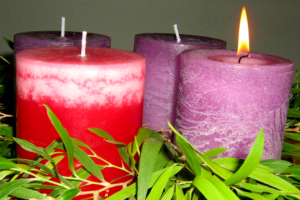 Sometimes, like Mulga Bill on his bicycle, we find ourselves hurtling into the future, or rushing to our next activity. We struggle to be fully present to this moment—the one we are living now.
Sometimes, like Mulga Bill on his bicycle, we find ourselves hurtling into the future, or rushing to our next activity. We struggle to be fully present to this moment—the one we are living now.
- Have we paused lately to notice the small signs of changes in the seasons?
- Do we sometimes stop to savour the smell of freshly mown grass? …or to enjoy what is right in front of our noses?
These little reflective breaks can help to keep us in the now. They put us in touch with our ‘good God’.
All the great spiritual writers invite us to try to live in the present. This moment, NOW, is the most important one we have. In fact, it is all we have. When Patrick Kavanagh tells us that “God is in the bits and pieces of every day”, we glimpse the nearness of our God in this precious moment, and in everyday happenings.
Mary MacKillop’s ‘good God’ is a faithful, gentle God who is at home with us. We don’t have to spend our lives seeking God elsewhere.
We light a candle to honour this present moment and to remind ourselves that the ground we are on is holy ground. Called, or uncalled, God is present. We sit in silence. Later on, we might take a long, slow, reflective walk.
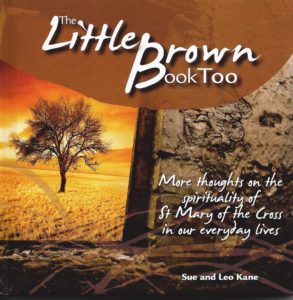
The above is an extract from The Little Brown Book Too (pages 136-137)
© Sue and Leo Kane 2011
Used with the kind permission of the publishers, St Paul’s Publications
Available online and from some Mary MacKillop Centres.
Download the print version of this reflection (PDF)
Photo: Advent candles by Sr Mary Ryan rsj. Used with permission.
